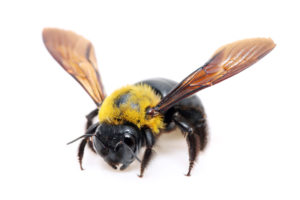Carpenter bee or wood boring bees
During this time of the year, we receive calls from homeowners who report finding small holes and sawdust on the wooden structure of their home, in furniture, or in fences. Typically, these signs are evidence of carpenter bee activity.

Carpenter bees are a wood destroying organism(WDO), which is a group of insects that includes many destructive pests such as termites, carpenter ants, and wood destroying fungus. Unlike termites, carpenter bees do not consume wood for sustenance, but instead, excavate wooden structures to create nests.
Carpenter bees greatly vary in size, growing between 8mm-25mm in length. They are yellow and black in color, and are sometimes mistaken for bumblebees. They can, however, be distinguished with closer observation because they lack the visible body hairs on their abdomen that are characteristic of bumblebees.
Unlike many other species of bees, carpenter bees are not social insects. They live solitary lives, typically only interacting with other bees to mate. Females will typically mate during the late spring or early summer.
After mating, female carpenter bees excavate wooden structures, both naturally occurring and artificial, to construct nests known as galleries. In the wild, these are often located inside stumps and rotting trees. Around the home, carpenter bees prefer to excavate dry, unpainted, and damaged wood. Common nesting areas include:
- Doors
- Windowsills
- Railing
- Roof eaves
- Fences
- Wooden Furniture
- Skylights
Carpenter bees do not always create new galleries, sometimes preferring to move into ones that were created in the previous season. However, they do tend to further excavate these galleries, increasing the damage to the structure. After they have constructed their nests, the carpenter bees will lay eggs, seal the gallery, and die shortly after. These eggs hatch, and the new bees take around 7 weeks to fully develop into adults. In warmer climates, it is common for carpenter bees to go through several life cycles before winter comes.
To keep your home safe from carpenter bees, it is important to remove conditions that are conducive for their excavation. Carpenter bees prefer to excavate unpainted and old wood, so keeping your home in good repair and repainting frequently can help to limit issues with carpenter bees.
As we mentioned above, carpenter bees do not consume wood. Their diet consists of plant pollen and nectar. This does not mean, however, that they do not pose a risk to your home. The excavation created by carpenter bees can be expensive and frustrating to repair, and any sign of carpenter bee activity should be treated as an immediate concern.
Here at Canton Termite and Pest Control, we have decades of experience treating pests of all kinds. Rather than applying basic, non-specific treatment methods, our technicians will thoroughly inspect your home and formulate a specific treatment plan to target your pest problems!
So if you want to keep your home safe from carpenter bees, or simply have a question, call us today at 770-479-1598!
Here’s to YOU living pest free!
By: Tim
